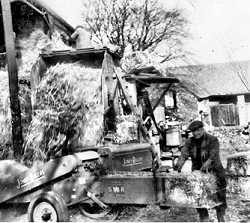

|
The arrival of the Thresher was a traditional event in the year on farms before the coming of the bagger combine. It was a time of cooperation between neighbours, because at least ten men were needed to thresh. There would be two pitching sheaves from the Rick onto the thresher, two cutting the sheaf cords and feeding it into the drums, two taking away the sacks of corn and the occasional bag of weed seeds, two on the straw, and always the two men who came with the machine, and the tractor that pulled it and drove the mechanism once it had been set up.
For West Yeo help came from Dart Raffe and Hellingshayes. The tackle would be set up the night before and at West Yeo a start was guaranteed in the morning as the corn was stacked under cover. Dust and noise were part of the scene, but work would continue until lunchtime, when there would be a cooked meal in the farmhouse, beef stew, or a joint of lamb, with potatoes and vegetables. This would be followed by suet pudding or trifle or blackberry and apple pie, and all washed down with home made cider and mugs of tea. It was traditional at West Yeo that the farmers wife and daughter never sat down at the table. If by some mischance the number at table was 13, then an extra chair was brought and one of the children made to sit and make the number up to 14. The men wore breeches and leggings, braces, waistcoats, and collarless shirts. The jackets were of a tweed mixture and they wore lace-up boots. One workman is recalled as wearing trousers until the threshing day when a rat ran up his trousers. It was the same man who, when he passed on the weather forecast to the farmer, was told: "it must be right as You have got a better class of wireless than I have"Oats and barley were put in 2cwt sacks and wheat into two and a quarters. Horse and cart took the sacks to the barn until the arrival of the tractor. If straw was needed for thatching, then reed combing took place in the spring. Feeding corn into the drum was a knack; the cord of each sheaf had to be cut and the sheaf shaken out loosely as it was fed in, otherwise a groaning noise came from inside. When broad beans were threshed there was sometimes more than a groan, as beans could be thrown back up at the feeder, who had to wear goggles for beans. There were other hazards, once a feeder took of his jacket which slipped into the drum, jamming the works. The only comment from his mates was: Was you in it, Jack?Previous Last Edited 03/07/2006 Copyright © 2000-2006 Witheridge Unless otherwise indicated on the page in question, the photographic images reproduced on this site belong to the Witheridge Archives, and, as such may not be reproduced for commercial purposes without written permission. However, you are welcome to use any of the photographs belonging to the archive for personal and/or non-commercial use. Any material shown as not being owned by the archive may not be reproduced in any form without first receiving written permission from the owner of the material in question. |


